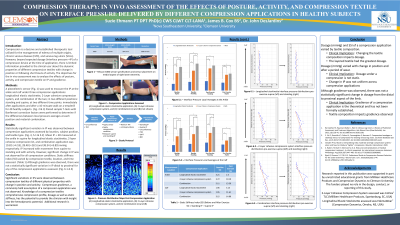Clinical Research
(CR-019) Compression Therapy: In vivo assessment of the effects of posture, activity, and compression textile on interface pressure delivered by different compression applications in healthy subjects
Friday, April 28, 2023
7:15 PM - 8:30 PM East Coast USA Time

James Cox, BS Bioengineering – M.S. Student, Department of Bioengineering, Clemson University; John DesJardins, PhD – Department of Bioengineering – Clemson University
Introduction: Compression is a decisive and established therapeutic tool utilized for the management of edema of multiple origins, chronic venous disease (CVD), and venous leg ulcers (VLUs). 1-5 However, beyond expected dosage (interface pressure =IP) of a compression device at the time of application, there is limited information provided to the clinical user about the dynamic properties of different compression textiles with change in position or following short bouts of activity. The objectives for the in vivo assessment was to analyze the effects of posture, activity, and compression textile on IP and gradients achieved with three different compression applications.
Methods: A piezoelectric sensor was used to measure the IP at the ankle and the calf under three compression applications: longitudinal elastic stockinette, 2-layer cohesive compression kit, and combination of the two; in two different positions: standing and supine; at two different time points: immediately after applications and after a 10-minuate walk on a treadmill for 40 healthy subjects.
Paired sample T-tests with Bonferroni correction factors were performed to determine if the differences between local pressure averages at each position and material combination.
Results: Statistically significant variation in IP was observed between compression applications assessed by location, subject position, and textile type. Mean IP ± SD measured at the ankle in supine for longitudinal elastic stockinette, 2-layer cohesive compression kit, and combination application was 10.82 (±4.18), 28.48(±28.5) and 38.34(±8.89) mmHg respectively. IP increased with movement from supine to standing and with activity. However, significant change in IP was not observed for all compression conditions. Static stiffness index (SSI) varied by compression textile, location, and time assessed. There was not a statistically significant variation in IP between the ankle and calf for any of the compression applications assessed.
Discussion: Significant variations in IPs were observed between compression textiles of
different physical properties with change in position and activity. Compression gradience, a commonly held assumption of a compression application was not observed. Knowledge of a compression textiles comprehensive compression profile, dosage as well as static stiffness, has the potential to provide the clinician with insight into the hemodynamic potential. Additional research is warranted.
Methods: A piezoelectric sensor was used to measure the IP at the ankle and the calf under three compression applications: longitudinal elastic stockinette, 2-layer cohesive compression kit, and combination of the two; in two different positions: standing and supine; at two different time points: immediately after applications and after a 10-minuate walk on a treadmill for 40 healthy subjects.
Paired sample T-tests with Bonferroni correction factors were performed to determine if the differences between local pressure averages at each position and material combination.
Results: Statistically significant variation in IP was observed between compression applications assessed by location, subject position, and textile type. Mean IP ± SD measured at the ankle in supine for longitudinal elastic stockinette, 2-layer cohesive compression kit, and combination application was 10.82 (±4.18), 28.48(±28.5) and 38.34(±8.89) mmHg respectively. IP increased with movement from supine to standing and with activity. However, significant change in IP was not observed for all compression conditions. Static stiffness index (SSI) varied by compression textile, location, and time assessed. There was not a statistically significant variation in IP between the ankle and calf for any of the compression applications assessed.
Discussion: Significant variations in IPs were observed between compression textiles of
different physical properties with change in position and activity. Compression gradience, a commonly held assumption of a compression application was not observed. Knowledge of a compression textiles comprehensive compression profile, dosage as well as static stiffness, has the potential to provide the clinician with insight into the hemodynamic potential. Additional research is warranted.

.png)